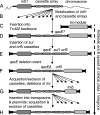The evolution of class 1 integrons and the rise of antibiotic resistance
- PMID: 18487337
- PMCID: PMC2447024
- DOI: 10.1128/JB.00152-08
The evolution of class 1 integrons and the rise of antibiotic resistance
Abstract
Class 1 integrons are central players in the worldwide problem of antibiotic resistance, because they can capture and express diverse resistance genes. In addition, they are often embedded in promiscuous plasmids and transposons, facilitating their lateral transfer into a wide range of pathogens. Understanding the origin of these elements is important for the practical control of antibiotic resistance and for exploring how lateral gene transfer can seriously impact on, and be impacted by, human activities. We now show that class 1 integrons can be found on the chromosomes of nonpathogenic soil and freshwater Betaproteobacteria. Here they exhibit structural and sequence diversity, an absence of antibiotic resistance genes, and a phylogenetic signature of lateral transfer. Some examples are almost identical to the core of the class 1 integrons now found in pathogens, leading us to conclude that environmental Betaproteobacteria were the original source of these genetic elements. Because these elements appear to be readily mobilized, their lateral transfer into human commensals and pathogens was inevitable, especially given that Betaproteobacteria carrying class 1 integrons are common in natural environments that intersect with the human food chain. The strong selection pressure imposed by the human use of antimicrobial compounds then ensured their fixation and global spread into new species.
Figures


References
-
- Barlow, R., and K. Gobius. 2006. Diverse class 2 integrons from beef cattle sources. J. Antimicrob. Chemother. 581133-1138. - PubMed
-
- Boucher, Y., M. Labbate, J. Koenig, and H. Stokes. 2007. Integrons: mobilizable platforms that promote genetic diversity in bacteria. Trends Microbiol. 15301-309. - PubMed
Publication types
MeSH terms
Substances
Associated data
- Actions
- Actions
- Actions
- Actions
- Actions
- Actions
- Actions
- Actions
- Actions
- Actions
- Actions
- Actions
- Actions
- Actions
- Actions
- Actions
- Actions
- Actions
- Actions
- Actions
- Actions
- Actions
- Actions
- Actions
- Actions
- Actions
- Actions
- Actions
- Actions
- Actions
- Actions
- Actions
- Actions
- Actions
- Actions
- Actions
- Actions
- Actions
- Actions
- Actions
- Actions
- Actions
- Actions
- Actions
LinkOut - more resources
Full Text Sources
Medical

